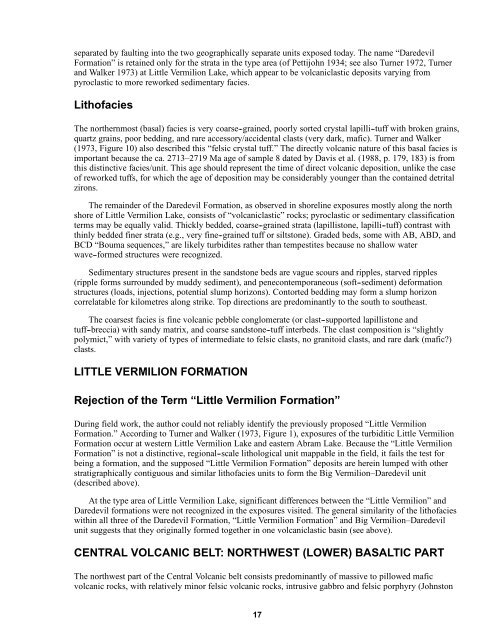Regional Geology, Sioux Lookout Orogenic Belt - Geology Ontario
Regional Geology, Sioux Lookout Orogenic Belt - Geology Ontario
Regional Geology, Sioux Lookout Orogenic Belt - Geology Ontario
You also want an ePaper? Increase the reach of your titles
YUMPU automatically turns print PDFs into web optimized ePapers that Google loves.
separated by faulting into the two geographically separate units exposed today. The name “Daredevil<br />
Formation” is retained only for the strata in the type area (of Pettijohn 1934; see also Turner 1972, Turner<br />
and Walker 1973) at Little Vermilion Lake, which appear to be volcaniclastic deposits varying from<br />
pyroclastic to more reworked sedimentary facies.<br />
Lithofacies<br />
The northernmost (basal) facies is very coarse--grained, poorly sorted crystal lapilli--tuff with broken grains,<br />
quartz grains, poor bedding, and rare accessory/accidental clasts (very dark, mafic). Turner and Walker<br />
(1973, Figure 10) also described this “felsic crystal tuff.” The directly volcanic nature of this basal facies is<br />
important because the ca. 2713–2719 Ma age of sample 8 dated by Davis et al. (1988, p. 179, 183) is from<br />
this distinctive facies/unit. This age should represent the time of direct volcanic deposition, unlike the case<br />
of reworked tuffs, for which the age of deposition may be considerably younger than the contained detrital<br />
zirons.<br />
The remainder of the Daredevil Formation, as observed in shoreline exposures mostly along the north<br />
shore of Little Vermilion Lake, consists of “volcaniclastic” rocks; pyroclastic or sedimentary classification<br />
terms may be equally valid. Thickly bedded, coarse--grained strata (lapillistone, lapilli--tuff) contrast with<br />
thinly bedded finer strata (e.g., very fine--grained tuff or siltstone). Graded beds, some with AB, ABD, and<br />
BCD “Bouma sequences,” are likely turbidites rather than tempestites because no shallow water<br />
wave--formed structures were recognized.<br />
Sedimentary structures present in the sandstone beds are vague scours and ripples, starved ripples<br />
(ripple forms surrounded by muddy sediment), and penecontemporaneous (soft--sediment) deformation<br />
structures (loads, injections, potential slump horizons). Contorted bedding may form a slump horizon<br />
correlatable for kilometres along strike. Top directions are predominantly to the south to southeast.<br />
The coarsest facies is fine volcanic pebble conglomerate (or clast--supported lapillistone and<br />
tuff--breccia) with sandy matrix, and coarse sandstone--tuff interbeds. The clast composition is “slightly<br />
polymict,” with variety of types of intermediate to felsic clasts, no granitoid clasts, and rare dark (mafic?)<br />
clasts.<br />
LITTLE VERMILION FORMATION<br />
Rejection of the Term “Little Vermilion Formation”<br />
During field work, the author could not reliably identify the previously proposed “Little Vermilion<br />
Formation.” According to Turner and Walker (1973, Figure 1), exposures of the turbiditic Little Vermilion<br />
Formation occur at western Little Vermilion Lake and eastern Abram Lake. Because the “Little Vermilion<br />
Formation” is not a distinctive, regional--scale lithological unit mappable in the field, it fails the test for<br />
being a formation, and the supposed “Little Vermilion Formation” deposits are herein lumped with other<br />
stratigraphically contiguous and similar lithofacies units to form the Big Vermilion–Daredevil unit<br />
(described above).<br />
At the type area of Little Vermilion Lake, significant differences between the “Little Vermilion” and<br />
Daredevil formations were not recognized in the exposures visited. The general similarity of the lithofacies<br />
within all three of the Daredevil Formation, “Little Vermilion Formation” and Big Vermilion–Daredevil<br />
unit suggests that they originally formed together in one volcaniclastic basin (see above).<br />
CENTRAL VOLCANIC BELT: NORTHWEST (LOWER) BASALTIC PART<br />
The northwest part of the Central Volcanic belt consists predominantly of massive to pillowed mafic<br />
volcanic rocks, with relatively minor felsic volcanic rocks, intrusive gabbro and felsic porphyry (Johnston<br />
17

















